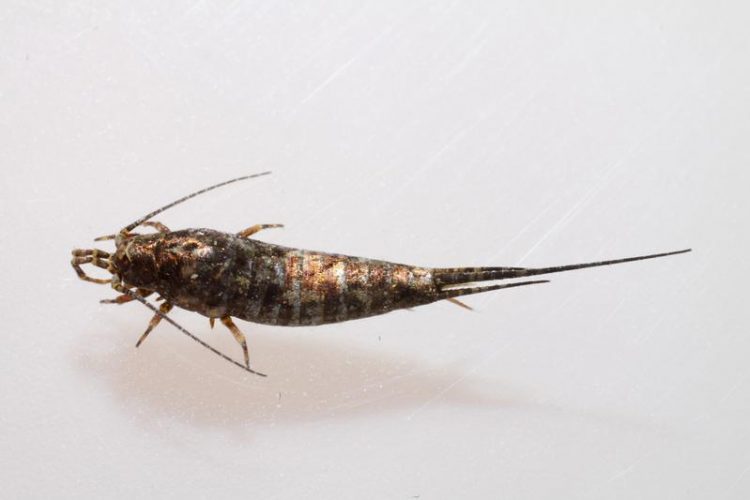The first insects were not yet able to smell well

Jumping bristletail Lepismachilis y-signata Alexander Schneeberg
An insect’s sense of smell is vital to its survival. Only if it can trace even tiny amounts of odor molecules is it is able to find food sources, communicate with conspecifics, or avoid enemies.
According to scientists at the Max Planck Institute for Chemical Ecology, many proteins involved in the highly sensitive odor perception of insects emerged rather late in the evolutionary process.
The very complex olfactory system of modern insects is therefore not an adaptation to a terrestrial environment when ancient insects migrated from water to land, but rather an adaptation that appeared when insects developed the ability to fly. The results were published in the Open Access Journal eLife (eLife, March 26, 2014, doi: 10.7554/elife.02115)
Many insect species employ three families of receptor proteins in order to perceive thousands of different environmental odors. Among them are the olfactory receptors. They form a functional complex with another protein, the so-called olfactory receptor co-receptor, which enables insects to smell the tiniest amounts of odor molecules in their environment very rapidly.
Crustaceans and insects share a common ancestor. Since crustaceans do not have olfactory receptors, previously scientists assumed that these receptors evolved as an adaptation of prehistoric insects to a terrestrial life. This hypothesis is also based on the assumption that for the ancestors of recent insects, the ability to detect odor molecules in the air rather than dissolved in water was of vital importance.
Early research on insect olfactory receptors focused entirely on insects with wings. Ewald Große-Wilde and Bill S. Hansson and their colleagues from the Max Planck Institute for Chemical Ecology in Jena, Germany, have now taken a closer look at the olfactory system of wingless insects, which − in evolutionary terms − are older than winged insects: the jumping bristletail Lepismachilis y-signata and the firebrat Thermobia domestica, which are both wingless, as well as the leaf insect Phyllium siccifolium, which is winged and was used as a control. As all three studied insect species emerged at different times in insect evolution, the scientists wanted to track the historical development of olfactory receptors.
Christine Mißbach, first author of the study, analyzed the active genes in the insect antennae where the olfactory receptors are located and describes her discovery this way: “Astonishingly, the firebrat, which is more closely related to flying insects, employs several co-receptors, while the odorant receptors themselves are absent.”
However, the researchers did not find any evidence for an olfactory system which is based on odorant receptors in the most basal insect, the jumping bristletail.
“According to these findings, the receptor family which is important for olfaction in recent insects evolved long after the migration of insects from water to land,” Ewald Große-Wilde summarizes. The researchers are convinced that the main olfactory receptors evolved independently of the co-receptor long after insects had adapted to terrestrial life. They hope that further analyses will reveal why some insect species have only co-receptors, no main receptors, and also clarify the function these co-receptors have on their own. [AO]
Original Publication:
Missbach, C., Dweck, H., Vogel, H., Vilcinskas, A., Stensmyr, M. C., Hansson, B. S., Grosse-Wilde, E. (2014). Evolution of insect olfactory receptors. eLife, doi:10.7554/elife.02115.
http://elife.elifesciences.org/content/3/e02115
Further Information:
Dr. Ewald Große-Wilde, Max Planck Institute for Chemical Ecology, E-Mail grosse-wilde@ice.mpg.de
Contact and Picture Requests:
Angela Overmeyer M.A., Max Planck Institute for Chemical Ecology, Hans-Knöll-Str. 8, 07743 Jena, +49 3641 57-2110, overmeyer@ice.mpg.de
Download of high-resolution images via http://www.ice.mpg.de/ext/735.html
Media Contact
All latest news from the category: Life Sciences and Chemistry
Articles and reports from the Life Sciences and chemistry area deal with applied and basic research into modern biology, chemistry and human medicine.
Valuable information can be found on a range of life sciences fields including bacteriology, biochemistry, bionics, bioinformatics, biophysics, biotechnology, genetics, geobotany, human biology, marine biology, microbiology, molecular biology, cellular biology, zoology, bioinorganic chemistry, microchemistry and environmental chemistry.
Newest articles

A universal framework for spatial biology
SpatialData is a freely accessible tool to unify and integrate data from different omics technologies accounting for spatial information, which can provide holistic insights into health and disease. Biological processes…

How complex biological processes arise
A $20 million grant from the U.S. National Science Foundation (NSF) will support the establishment and operation of the National Synthesis Center for Emergence in the Molecular and Cellular Sciences (NCEMS) at…

Airborne single-photon lidar system achieves high-resolution 3D imaging
Compact, low-power system opens doors for photon-efficient drone and satellite-based environmental monitoring and mapping. Researchers have developed a compact and lightweight single-photon airborne lidar system that can acquire high-resolution 3D…





















